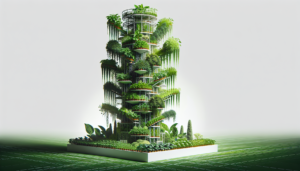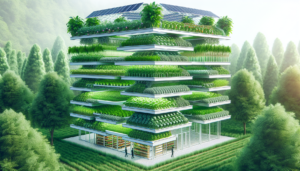
Have you ever wondered how vertical farming works? In this article, we will explore the fascinating world of vertical farming and uncover its inner workings. Vertical farming is an innovative and sustainable method of agriculture that involves growing crops in vertically stacked layers, often within a controlled indoor environment. By utilizing advanced technologies such as hydroponics and LED lighting, vertical farming maximizes space efficiency and minimizes the use of natural resources. Join us as we unravel the secrets behind this revolutionary farming technique and discover how it could shape the future of food production.
What is vertical farming?
Vertical farming is an innovative agricultural technique that involves growing crops in vertically stacked layers or vertically inclined surfaces. Instead of using traditional methods of planting crops in large, horizontal fields, vertical farming utilizes indoor environments, such as warehouses or buildings, to cultivate plants in a controlled and efficient manner. This method maximizes the available space and allows for year-round production of a wide variety of crops.
Definition of vertical farming
Vertical farming can be defined as a farming technique that involves the cultivation of plants in vertically stacked layers, utilizing artificial lighting and controlled environments to optimize growth and productivity.
Concept behind vertical farming
The concept of vertical farming stems from the need to address various challenges faced by traditional agriculture, such as limited arable land, unpredictable weather patterns, and the dependence on chemical inputs. By utilizing indoor spaces, vertical farming allows for controlled environments where factors like temperature, humidity, and lighting can be finely tuned to create optimal growing conditions. This approach also eliminates the need for soil, making it possible to grow crops in areas with poor soil quality or in urban locations where fertile land is limited.
Advantages of vertical farming
Vertical farming offers numerous advantages over traditional agriculture methods. One of the key advantages is the ability to grow crops in any location, regardless of climate or geographic limitations. This means that fresh produce can be grown and consumed locally, reducing transportation costs, carbon emissions, and the reliance on imported food. Vertical farming also reduces water usage significantly compared to traditional farming methods. By utilizing advanced irrigation systems and recirculating water, vertical farms can achieve up to 90% water savings. Additionally, vertical farming virtually eliminates the need for pesticides, herbicides, and fungicides, creating a more sustainable and environmentally friendly approach to food production. The ability to control the growing conditions in vertical farms also results in faster growth cycles and higher yields, leading to increased productivity and profitability.
Key Components of Vertical Farming
The success of vertical farming relies on several key components that work together to create optimal growing conditions for plants. These components include building structure, growing medium, lighting, climate control, nutrient delivery system, irrigation system, and automation and monitoring.
Building Structure
The building structure is a crucial component of vertical farming as it provides the framework for cultivating plants in a vertical space. There are various types of building structures used in vertical farming, including converted warehouses, high-rise buildings, or purpose-built structures. The choice of building structure depends on factors such as available space, location, and scalability. It is important to maximize vertical space utilization in order to achieve higher yields and optimize production efficiency. Vertical farm design should also consider factors such as structural integrity, access to natural light, and ease of workflow for workers.
Growing Medium
The growing medium is the material in which plants are grown in a vertical farm, replacing the need for soil. Different types of growing mediums can be used, including hydroponic systems that use nutrient-rich water or substrates such as coconut coir, perlite, or rockwool. Each growing medium has its own benefits and drawbacks, and the choice depends on the specific crop requirements, water retention capacities, and aeration needs. The growing medium plays a critical role in providing support to the roots, ensuring efficient nutrient absorption, and facilitating drainage.
Lighting
Lighting is a vital component of vertical farming as it replaces natural sunlight and provides the necessary energy for photosynthesis. Artificial lighting systems, such as LED or fluorescent lights, are used to provide the specific light spectrum needed for plant growth. Different crops have different light requirements, so the lighting system design should consider factors such as light intensity, quality, duration, and positioning. Optimal light spectrum ensures that plants receive the right amount and type of light throughout their growth cycle, promoting healthy leaf development, flower production, and overall plant growth.
Climate Control
Maintaining consistent temperature and humidity is crucial for the success of a vertical farm. Controlled environments allow farmers to optimize plant growth and minimize the risk of diseases or pests. Various methods can be employed for temperature and humidity control, including HVAC systems, evaporative cooling, and dehumidifiers. Ventilation and air circulation systems are also important for removing excess heat or CO2 and distributing fresh air evenly within the vertical farm. Maintaining proper airflow and controlling the climate creates a stable and favorable environment for plant growth.
Nutrient Delivery System
The nutrient delivery system is responsible for providing plants with the necessary nutrients they need to grow and thrive. Hydroponics and aeroponics are two common methods used in vertical farming. Hydroponics involves growing plants in nutrient-rich water solutions, while aeroponics involves misting the roots with a nutrient-rich solution. These systems provide greater control over the nutrient levels and promote faster growth rates. Choosing the right nutrient delivery system depends on factors such as crop type, space availability, and resource efficiency.
Irrigation System
Efficient and precise irrigation is crucial for maintaining optimal moisture levels in the growing medium and ensuring proper nutrient uptake by the plants. Vertical farms employ various types of irrigation systems, including drip irrigation, flood and drain systems, or aeroponic misting systems. Automated irrigation and fertigation systems, which combine irrigation with nutrient delivery, help in reducing labor requirements and ensuring consistent and controlled watering schedules. Monitoring systems and sensors can be incorporated to measure moisture levels, allowing for real-time adjustments and reducing water wastage.
Automation and Monitoring
Automation plays a significant role in vertical farming, enabling increased efficiency and precision throughout the cultivation process. Automated systems can control various factors such as lighting, climate control, irrigation, and nutrient delivery, minimizing human intervention and optimizing resource usage. Sensor technologies are used to monitor plant health indicators such as temperature, humidity, CO2 levels, and nutrient levels. This data is then analyzed to identify potential issues, optimize growth conditions, and make informed decisions that lead to improved crop quality and yield.
Challenges and Limitations of Vertical Farming
While vertical farming offers numerous benefits, it also faces certain challenges and limitations that need to be addressed for widespread adoption and scalability.
Energy consumption
One of the major challenges in vertical farming is the high energy consumption associated with providing artificial lighting, maintaining climate control, and powering automation systems. Energy-efficient solutions, such as the use of LED lights and advanced HVAC systems, are being developed to reduce energy requirements. Integration of renewable energy sources, such as solar panels, can also help minimize the carbon footprint of vertical farms.
Initial setup cost
Setting up a vertical farm can be expensive, primarily due to the costs associated with building infrastructure, purchasing equipment and technology, and implementing automation systems. However, with advancements in technology and increasing demand for sustainable food production, the costs are expected to decrease over time. Government subsidies and support for vertical farming initiatives can also help offset the initial investment.
Crop selection and productivity
Not all crops are suitable for vertical farming due to their specific requirements and growth patterns. Leafy greens and herbs are commonly grown in vertical farms due to their high yield and short growth cycles. However, crops with large root systems or those that require larger growing spaces may not be suitable for this method. Striving for continuous improvement and research in crop selection and productivity can help expand the range of crops that can be successfully cultivated in vertical farms.
Space limitations
While vertical farming allows for efficient space utilization, there are physical limitations to consider. The number of tiers or levels that can be created within a vertical farming structure is limited, and certain crops may require more vertical space due to their height or growth patterns. Expanding the available space by utilizing unused areas within buildings or embracing innovative architectural designs can help overcome this limitation.
Scaling challenges
Scaling up vertical farming operations to meet the demands of larger communities or regions can be challenging. Managing logistics, including transportation, storage, and distribution, becomes more complex with increased production volumes. Developing scalable business models and establishing partnerships within the food supply chain can help address these challenges and ensure the viability of large-scale vertical farming operations.
Overall, vertical farming is an innovative and sustainable approach to food production. By leveraging technology and controlled environments, this method offers numerous advantages, including year-round crop production, reduced water usage, and enhanced resource efficiency. While certain challenges exist, ongoing advancements in technology and continuous improvement in cultivation practices are paving the way for vertical farming to become a vital component of future food systems.







